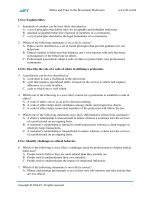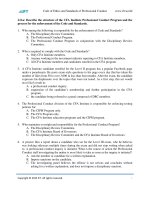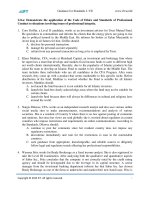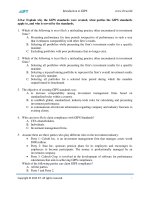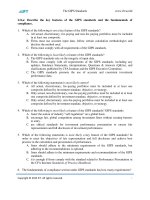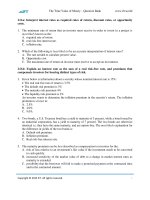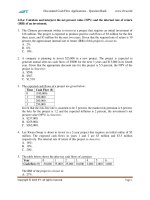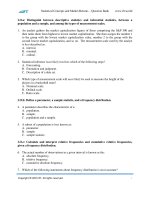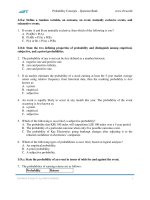CFA 2018 quest bank r04 introduction to the global investment performance standards (GIPS) q bank
Bạn đang xem bản rút gọn của tài liệu. Xem và tải ngay bản đầy đủ của tài liệu tại đây (187.84 KB, 5 trang )
Introduction to GIPS
www.ift.world
LO.a: Explain why the GIPS standards were created, what parties the GIPS standards
apply to, and who is served by the standards.
1. Which of the following is most likely a misleading practice often encountered in investment
firms?
A. Presenting performance for time periods irrespective of performance in such a way
that it enhances comparability with other firm’s results.
B. Selecting all portfolios while presenting the firm’s investment results for a specific
mandate.
C. Excluding portfolios with poor performance that no longer exist.
2. Which of the following is least likely a misleading practice often encountered in investment
firms?
A. Selecting all portfolios while presenting the firm’s investment results for a specific
mandate.
B. Selecting a top-performing portfolio to represent the firm’s overall investment results
for a specific mandate.
C. Selecting all portfolios for a selected time period during which the mandate
outperformed its benchmark.
3. The objective of creating GIPS standards was:
A. to increase comparability among investment management firms based on
standardized rules within a country.
B. to establish global, standardized, industry-wide rules for calculating and presenting
investment performance.
C. to communicate all relevant information regarding company and industry forecasts to
existing clients.
4. Who can most likely claim compliance with GIPS Standards?
A. CFA charterholders.
B. Individuals.
C. Investment management firms.
5. Assume there are three parties who play different roles in the investment industry:
Party 1: Calsoft Inc. is an investment management firm that manages assets worth
$900 million.
Party 2: Stan Inc. sponsors pension plans for its employees and encourages its
employees to become participants. The money is professionally managed by an
investment company.
Party 3: Caltech Corp. is involved in the development of software for performance
calculations that aids in achieving GIPS compliance.
Which of the following parties can claim GIPS compliance?
A. All the parties.
B. Party 1 and Party 2.
Copyright © 2015 IFT. All rights reserved.
1
Introduction to GIPS
www.ift.world
C. Party 1.
6. IDC Asset Management Company has three funds: Premium Equity, Dynamic Bond Fund,
and Small-Cap Growth Opportunities. The company claims GIPS compliance for Dynamic
Bond Fund. IDC is defined as the firm. Assuming there is no distinction in the investment
process or client type, is the claim for compliance accurate as per GIPS Standards?
A. Yes, since the requirements for claiming compliance have been met.
B. No, because claiming partial compliance is not allowed.
C. No, because the provisions do not apply to fixed income investments.
7. Which
for:
A.
B.
C.
of the following statements is most likely true? A firm can claim GIPS compliance
a single product.
a single fund.
an asset management division defined as firm catering exclusively to institutional
investors across geographies managing all types of asset classes.
8. Claiming compliance with GIPS Standards is:
A. mandatory.
B. voluntary.
C. set to become mandatory in order to participate in competitive bids from 2017.
LO.b: Explain the construction and purpose of composites in performance reporting.
9. According to the Global Investment Performance Standards (GIPS), the criteria for including
portfolios in composites is:
A. all actual fee-paying, discretionary portfolios must be included in at least one
composite.
B. all discretionary portfolios must be included in a composite.
C. all actual fee-paying portfolios must be included in a composite.
10. Which of the followings statements best describe a composite?
A. A single portfolio for a specific client type such as a retail or institutional investor.
B. One or more portfolios managed to a similar investment mandate, objective or
strategy.
C. One or more top-performing portfolios provided it is a pre-established criteria.
11. Which of the following must be included in a composite?
A. Non-fee paying, discretionary portfolios.
B. Non-fee paying, non-discretionary portfolios.
C. Fee paying, discretionary portfolios.
Copyright © 2015 IFT. All rights reserved.
2
Introduction to GIPS
www.ift.world
12. Assume MA Asset Management Company has a composite called Macro Fixed Income
Composite that caters to fixed income portfolios. Which of the following funds will least
likely be a fit in this composite?
A. A fund with high liquidity that invests in debt instruments.
B. A fund that invests in a portfolio of money market instruments.
C. A fund that generates returns in line with the performance of gold.
LO.c: Explain the requirements for verification.
13. The purpose of verification is:
A. that it ensures the accuracy of any composite presentation.
B. to increase confidence in the firm’s claim of compliance.
C. to ensure the performance of a specific fund or mandate is as presented.
14. Verification of GIPS compliance is:
A. done by an independent third-party.
B. mandatory to claim compliance.
C. done voluntarily by the firm under the supervision of the CFA Institute.
15. Which of the following statements regarding verification is least accurate?
A. The verification procedures are different for each firm.
B. Though compliance is firm-wide, verification can be done for a specific fund or
composite.
C. Verification tests whether the composite construction requirements have been
complied with on a firm-wide basis.
Copyright © 2015 IFT. All rights reserved.
3
Introduction to GIPS
www.ift.world
Solutions
1. C is correct. Excluding portfolios with poor performance is known as survivorship bias – an
often seen misleading practice.
2. A is correct. Selecting top-performing portfolios is a misleading practice known as
representative accounts. Presenting performance for a selected time period when the mandate
outperformed the benchmark is also a misleading practice.
3. B is correct. C is incorrect because the objective is to communicate all relevant information
of historical results to prospective clients.
4. C is correct. Only investment management firms can claim compliance. Individuals,
charterholders, and software to implement the Standards cannot claim compliance.
5. C is correct. Only investment management firms that actually manage assets can claim
compliance. The other two cannot.
6. B is correct. Since there is no distinction in the market or client type (institution/retail
investors) and the investment process, partial compliance is not allowed. GIPS encourages
firms to use the broadest definition of the firm.
7. C is correct. A single product or a single fund cannot claim compliance.
8. B is correct. It is voluntary, but it increases the competitiveness of a GIPS-complaint firm,
while competing for bids on a global platform against non-compliant ones. It increases the
trust among prospective clients.
9. A is correct. All actual fee-paying, discretionary portfolios must be included in at least one
composite. Actual non-fee paying discretionary portfolios may be included in at least one
composite with appropriate disclosure.
10. B is correct. A composite is an aggregation of one or more portfolios managed according to a
similar investment mandate, objective, or strategy.
11. C is correct.
12. C is correct. A gold ETF will least likely fit in a composite with a fixed income investment
strategy.
13. B is correct. Verification does not ensure the accuracy of any composite. It merely tests if all
the composite construction requirements have been met, and if policies are in place for the
firm to calculate, present performance and claim compliance with the GIPS Standards
Copyright © 2015 IFT. All rights reserved.
4
Introduction to GIPS
www.ift.world
14. A is correct. A firm cannot perform its own verification.
15. B is correct. Verification cannot be done for a fund or a composite. It is firm-wide just as
claiming compliance is.
Copyright © 2015 IFT. All rights reserved.
5

